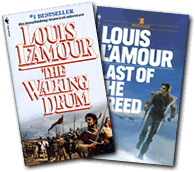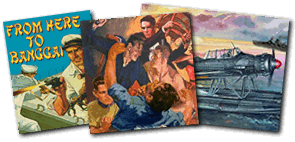 |
For Louis, the story didn't end
with the Western, his eyes were
always on the horizon . . . |
Beau L'Amour:

Louis was famous for writing westerns but just as popular were novels like The Walking Drum, a epic set just after the crusades and the Cold War thriller, Last of the Breed. As most of you know, Louis did not start out writing westerns. In the beginning of his career he wrote very personal stories about his times and adventures, then he wrote pulp adventures set in exotic locations and he wrote crime stories, many set in the world of professional boxing.
One of the more interesting projects Paul O’Dell and I have done was to create a website that is the companion piece to The Collected Short Stories Volume Four – The Adventure Stories. louislamourgreatadventure.com is like a guided tour through these stories.


For the “Around the World With Louis L’Amour” section we take a look at Louis’s life and the stories that were most closely related to it. There are pictures of Louis from those times, maps and photos of the places he visited, ships he served on, and people he knew. There is all kinds of stuff, from his draft registration card to maps he used in WWII and business cards he picked up in Shanghai in the 1920s. These are used to illustrate stories that may have come directly form Louis’s life.
The “Literary Adventure” section explores some of Louis’s later adventure writings, material that was lost for many years when all Louis could sell were Westerns. Again we tried to provide maps and photos from the exotic locations he wrote about.

But the most fun for me was creating the “Classic Adventures” section. This recreates the world of the pulp heroes that were Louis’s earliest successes. It was a blast trying to capture the tone of 1930s and ’40 news casts, looking closely at the times that Louis was writing about, a world that had no idea what was about to happen. These stories of Dad’s were all contemporary adventure stories written about events as they were happening … you really get a different perspective on World War II when you realize that no one knew what was going to occur. Using newsreels, political cartoons, animation and some fictional exhibits intended to bridge some of the gaps between the stories, we try to build an entire reality around this book.